John Hurrell – 21 July, 2013
Jones in his placement seems interested in varieties of such compressed pools of illumination, or the lack of - ‘holes' or ‘tunnels' - in the bordering architectural planes. The individual square units, because of their groupings, take on anthropomorphic qualities, as if they were people standing in a line around a rectangular sports field or swimming pool.
This unusual exhibition of square fluorescent tube constructions and v-shaped woodblock prints is Aboriginal Australian Jonathan Jones’ second solo presentation at Tim Melville. For this gallery his show has an unusual installational feel, the glowing light works taking up a large part of the space, leaning against the wall and reflecting off the shiny concrete floor. And although clearly referencing late sixties modernist artists like Flavin and Sonnier, it is intended to have a postcolonial inflection as well. Whether that interpretation is clearly apparent in this age of ‘death of the author/birth of the reader’ is of course the million dollar question. (Apparent to whom you might ask: which reader? From which community?)
The show consists of six fluorescent squares (several overlapping) and six framed prints. In his first solo show (2010) the glowing white tubes were in diamond configurations that relate now to the current v-shaped woodblocks. These prints are in pairs that accentuate either stacked up or undulating lines of vees. Some have diamond centres; others are in ‘half-diamond’ clusters. Jones (Wiradjuri / Kamilaroi) is especially interested in engraved Wiradjuri motifs (SE Australia) he found when researching in the British Museum. (It is interesting that they are very similar to some of the Pacific motifs used by Richard Killeen in his 1974 painting Constructivist Grid No. 3, currently on display in Auckland Art Gallery.)
The fluorescent squares reference the form of Aboriginal shelters known as gunyahs, where sheets of bark (or corrugated iron) are leant against a cliff, side of building or tree to serve as windbreaks, or screens from rain and sun. Some scholars, like Paul Memmott, consider that Aboriginal architecture was actually far more permanent than what has been generally acknowledged, that the significance of temporary shelters has been exaggerated, so it is intriguing that Jones mentions the latter. The propped up forms also allude to minimalist modernist artists like John McCracken whose lacquered ‘plank’ sculptures leaned against the gallery wall.
It is quite a shift from the vertical clusters of fixed diamonds and zigzagging tracks that ascend up the wall, to a horizontal alignment of less complicated, less compact modules that can be picked up and adjusted ‘by eye’ according to desired densities of light and shadow on the wall and floor.
Jones in his placement seems interested in varieties of such compressed pools of illumination, or the lack of - ‘holes’ or ‘tunnels’ - in the bordering architectural planes. The individual square units, because of their groupings, take on anthropomorphic qualities, as if they were people standing in a line around a rectangular sports field or swimming pool. Jones’ lack of formal repetition in positioning, his inventive arrangement (one is in isolation), gives each square of light individuality - with personality and even ‘psychic’ aura.
The reflections on the floor below and in the glass of the prints, as a foil to the blinding ‘real’, take on a metaphorical tinge as if a mediation via the perception of others, a filtered, indirect, second degree experience that has distance and intervening layering. The two levels together (the configurations and their reflections) could be interpreted as a comment on the social, on how individuals within a community are perceived by outsiders, on the dynamics and consequences of being looked at - a critique of anthropology.
John Hurrell
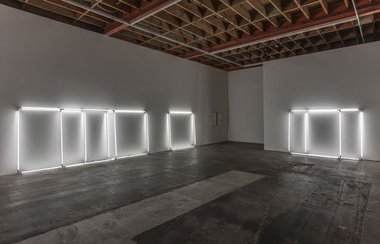

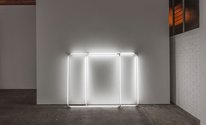
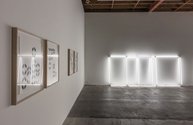

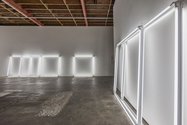
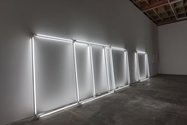
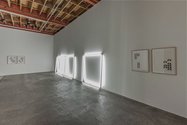
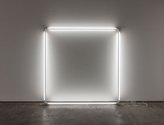


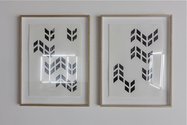
 Two Rooms presents a program of residencies and projects
Two Rooms presents a program of residencies and projects Advertising in this column
Advertising in this column



This Discussion has 0 comments.
Comment
Participate
Register to Participate.
Sign in
Sign in to an existing account.